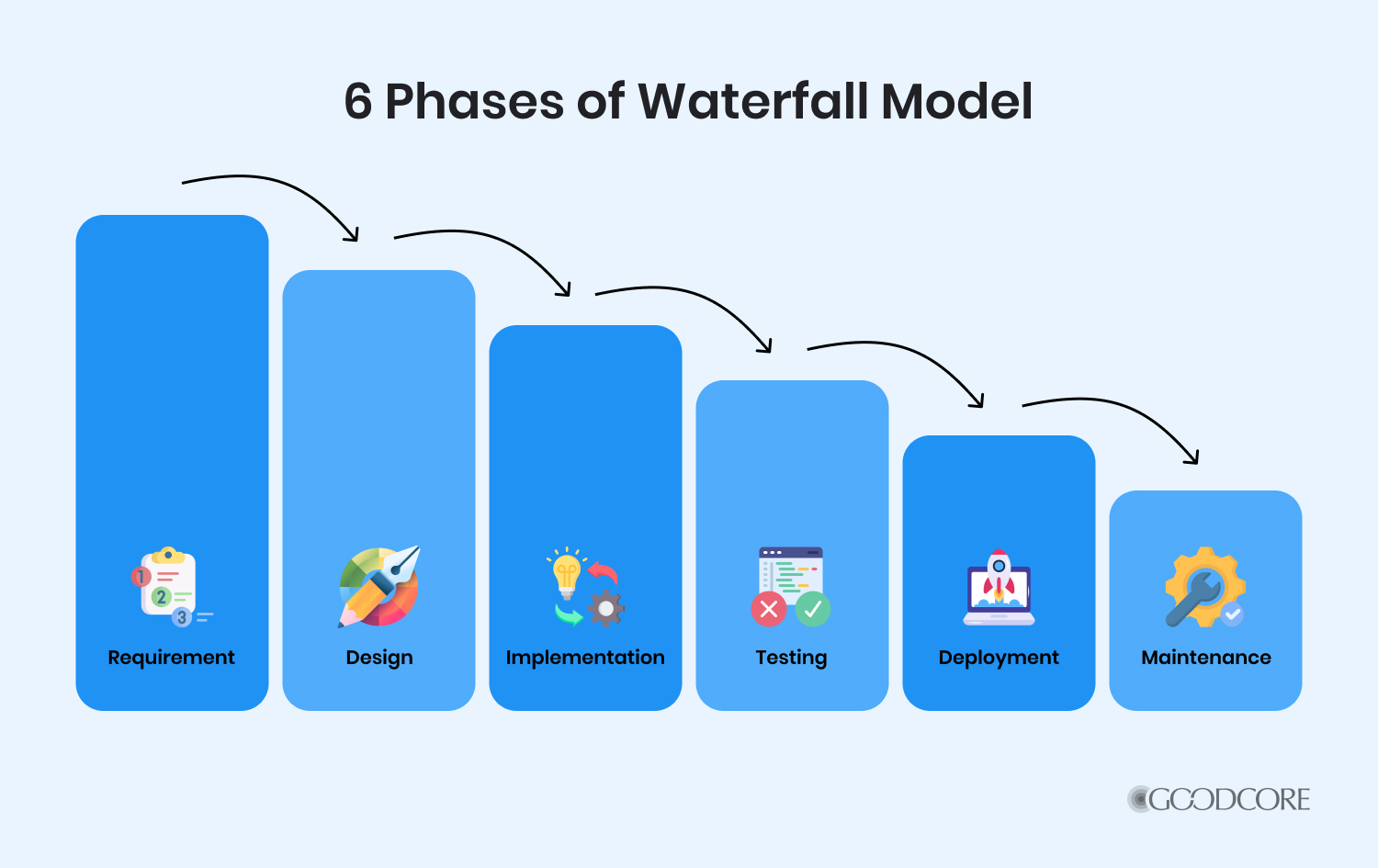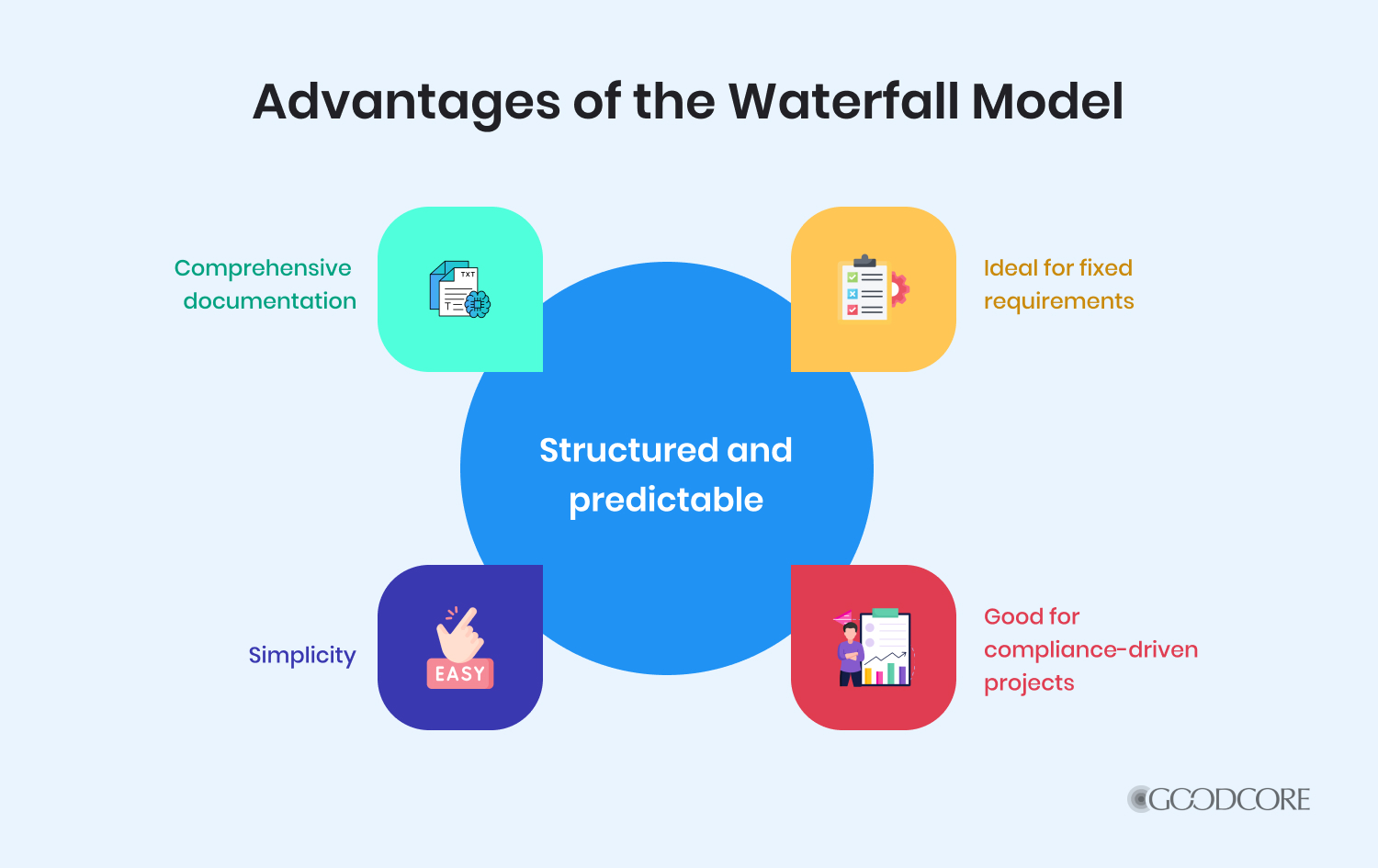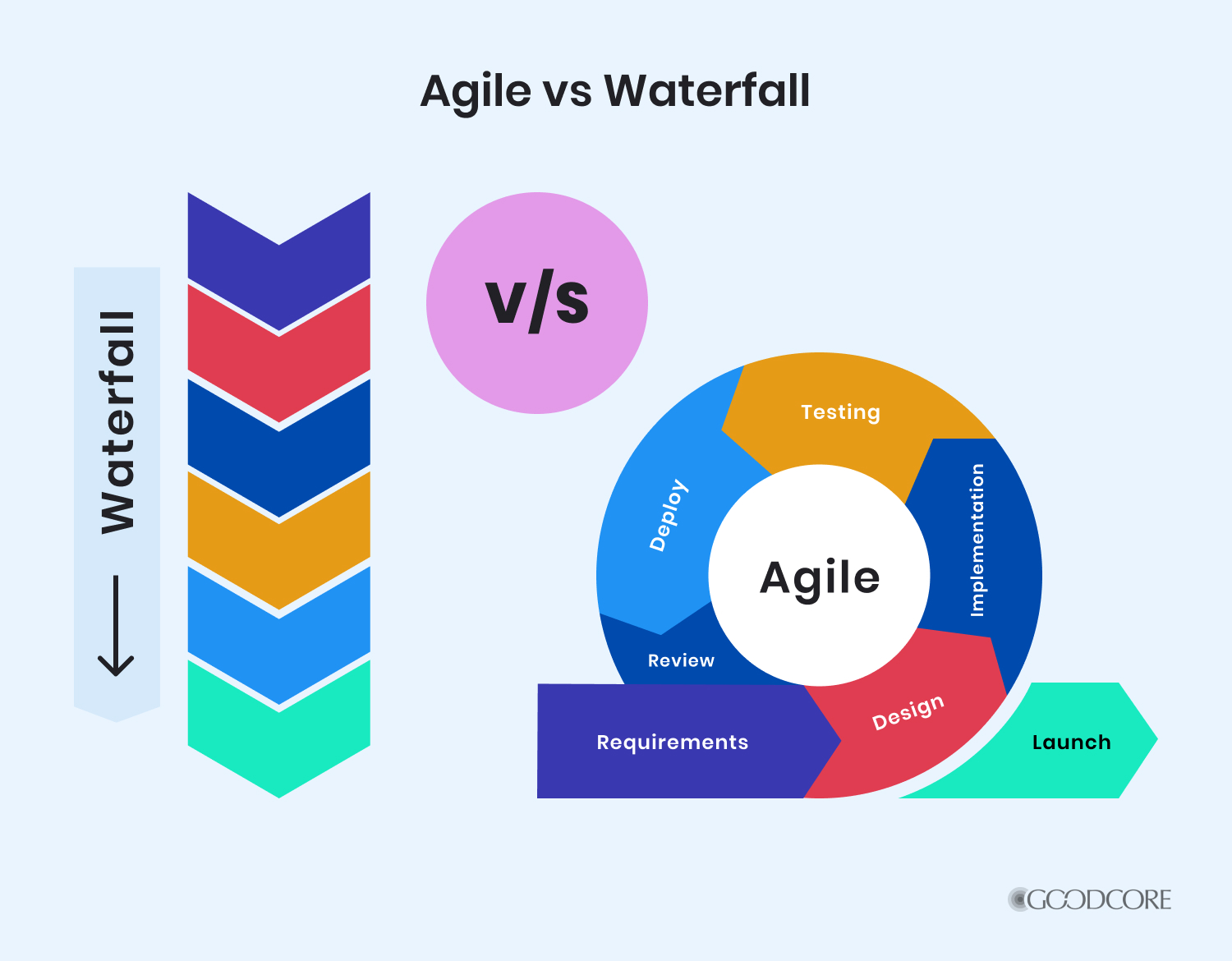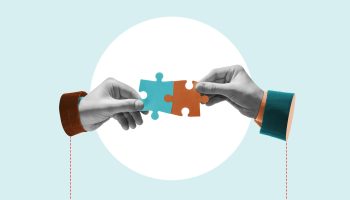Software development methodologies guide how teams plan, build, and deliver software. Over time, various approaches have emerged, each with unique strengths.
One of the earliest and most traditional models is the Waterfall method, a step-by-step process where each phase must be completed before moving on. While Agile dominates the conversation today, Waterfall still has its place.
Drawing on our experience as a bespoke software development company, we’ll explore the pros and cons of the Waterfall model to help you understand when it can be a smart choice, and when it might create challenges for your projects.
What is the Waterfall software development methodology?

Just like how in a waterfall, water smoothly flows from a height and drops into a stream or river, the Waterfall software development mechanism also works in the same way. That is, it starts from one step and then flows into the next phase, until the process comes down to the last step. This type of model is also called a linear software development model (meaning the steps come one after the other in a subsequent order and don’t overlap).
The model was first introduced in the 1970s, back when most tech systems were massive, expensive, and hard to modify once they were built. So naturally, having this structured and plan-it-all-upfront approach helped companies develop software in a much more efficient way.
Need help with your next software development project?
Our team will help you plan, design, and deliver software tailored to your business needs.
Software development services
Phases of the Waterfall model
The Waterfall software development methodology moves through six main stages, which we have discussed below:
1. Requirements
The first stage is where all the planning happens and where you lay everything out before the project begins. You start off by gathering all the requirements from the client or stakeholders involved in the project, like what features and functions will be included, what the software should do, who will use it, and how it should perform.
Once agreed upon, these requirements are considered locked, meaning it will be very tough (and expensive) to go back and make changes later.
2. Design
The second stage involves figuring out how to build the project, for example, creating the system architecture, choosing the tech stack, designing the user interface (UI), and detailing how each component will function.
Both the high-level design (overall system architecture) and low-level design (details for each module or feature) are prepared. The focus here is to create clear, technical blueprints so that developers know exactly what to do in the next step, i.e the implementation stage.
3. Implementation
Now the actual development begins. Based on the design documents that you came up with in the previous step, developers write the code for the software. Each module or feature is built according to plan, often in the same sequence in which they were designed.
Since the Waterfall model is linear, developers don’t go back to tweak designs – they stick to the plan and build what has already been agreed upon. This phase is usually the longest, as it converts design documents into a working product.
4. Testing
Once the software has been fully developed, it enters the testing phase. Here, the team will check whether the product works as it should. They will look for bugs, broken features, security issues, or anything that might cause problems for the users or affect customer experience. This stage is all about quality assurance and ensuring that everything runs smoothly and meets the original requirements.
5. Deployment
After the product passes the testing stage, it is now time to launch it into the real world. The software is delivered to the client, made live on servers, or distributed to the users. In most cases, this is a one-time launch event, especially for internal enterprise software. There isn’t much iteration after this point unless it has to go back for maintenance (that is also the last phase of the Waterfall process).
6. Maintenance
Launching the software does not mean that the work is done. The team has to provide support for any bugs that may arise, security updates, or minor improvements after the deployment stage.
Think of it as the “aftercare” phase, where you are maintaining the system and keeping it up-to-date. However, since in the Waterfall methodology, most of the work is done up front, it is very difficult to make any major changes, and companies often have to start a new cycle in that case.
The advantages of Waterfall methodology

So, now that we know what the Waterfall methodology is, let’s take a look at what benefits it has to offer.
Structured and predictable
If you are someone who likes setting a clear timeline and having a defined scope, you will appreciate the Waterfall model’s predictability and well-defined stages. From the start, everyone knows what is being built, how long it will take, and what the deliverables are. This is especially great for clients or stakeholders who want to know about the project’s requirements and details up front.
Comprehensive documentation
Since everything is documented at every stage, Waterfall leaves a solid paper trail. This makes it easier to onboard new developers, handle handovers more smoothly, or troubleshoot later, down the line.
Ideal for fixed requirements
For projects that have very clear and unchanging goals, Waterfall can be the perfect choice. For example, the model can be suitable for compliance-driven systems, internal tools with fixed processes, or projects with legal or contractual constraints.
However, if you need to frequently check in or might need to change the requirements of the project later, then it is better not to consider the Waterfall software development methodology.
Simplicity
Another advantage of the Waterfall model is that it has a very straightforward process and is much easier to follow than other methodologies like Agile and Scrum. This can be particularly beneficial for those companies that are new to software development (like non-tech startups). It is also easier to manage for stakeholders who want a detailed overview without getting into day-to-day decisions.
Good for compliance-heavy projects
In industries like healthcare, government, or finance, you often need a linear, traceable and documented process. The Waterfall model can be the perfect choice for such industries, as it makes it easier to pass audits and meet regulatory standards, along with providing detailed records.
The challenges of the Waterfall method
Now, let’s talk about the flip side of this model. Here are a few disadvantages of choosing the Waterfall software development methodology:
Rigid requirements
Waterfall depends on locking in concrete requirements before any development begins. This can be tough because, at the very start of a project, it’s hard to predict every detail or scenario. If something important gets missed, or if your business needs change later, those initial requirements may no longer fit. By the time you realise this, the project might be too far along to adjust without major delays or extra costs.
Inflexibility
The Waterfall method has a very structured, step-by-step approach. It moves from planning to design to development in a straight line, and there’s almost no turning back. This inflexible structure means the team can’t easily respond to new insights, market changes, or evolving customer demands. For startups and businesses in fast-moving industries, that lack of adaptability can be a big risk.
Minimal client feedback
In Waterfall projects, clients often only see the final product when everything is done. This means there’s a lack of client feedback during the process. If expectations shift or priorities evolve mid-project, there’s no built-in way to course-correct. The end result can be a product that technically matches the original requirements but doesn’t fully meet the client’s needs anymore.
No overlapping work
In Waterfall, work on different phases doesn’t overlap; each stage must be signed off before the next one begins. While this can create a clear, organised process, it also slows things down. For example, developers can’t start coding until the design phase is 100% complete, even if most of it is ready. This stop-and-go flow can cause delays and make the project less efficient overall.
Late testing
Testing usually happens near the end of a Waterfall project, after development is complete. The downside is that any design flaws, missed requirements, or bugs aren’t discovered until late in the process. Fixing these issues at this stage can be expensive and time-consuming, sometimes requiring teams to revisit earlier work or redesign parts of the system entirely.
Limited opportunities for revisions
Once a phase is completed and signed off, going back to make changes is rarely simple. This lack of revision opportunities means any scope adjustments later in the process can be costly. A seemingly small tweak like adding a new feature might require revisiting planning, design, and development steps that were considered “finished,” which can derail timelines and budgets.
When to use the Waterfall model?
With all the waterfall method’s advantages and disadvantages considered, here are some scenarios where the Waterfall software development model would be the perfect fit:
Projects with well-defined scope
If your project begins with a clear objective and established project requirements, Waterfall can be a strong choice. Because the model depends on a detailed planning phase, every requirement and deliverable is outlined before work starts. Tools like Gantt charts help track each milestone. This approach ensures everyone, developers, stakeholders, and clients, is aligned from day one, which reduces confusion and prevents last-minute changes.
Predictable projects
Some projects follow a stable and repeatable process, making them predictable projects. This could include updates to legacy systems, software built on mature technology, or repeat builds of an existing solution. In these cases, Waterfall’s inflexibility becomes a strength because there’s less need for frequent adjustments. The team can move through the phases with confidence, knowing the requirements will stay consistent.
Projects requiring tight budgets and timelines
For projects where an accurate budget estimate and predictable timeline are critical, Waterfall is a good choice. Because everything is planned and documented upfront, you can provide clients with a reliable cost and schedule before development starts. This predictability makes Waterfall especially appealing to clients who want financial clarity and minimal surprises during delivery.
Government contracts or highly regulated projects
Government projects or those in highly regulated industries (such as healthcare, defence, or finance) often require meticulous documentation, clear deliverables, and step-by-step approvals. Waterfall’s structured approach supports this well, with strong emphasis on requirement gathering and documentation at the start and consistent stakeholder engagement at predefined checkpoints. Its formality and technical documentation make compliance easier and audits more straightforward.
Small teams with clear roles
For small teams with clearly defined roles, Waterfall can simplify workflows. Since work on different phases doesn’t overlap, each person can focus entirely on their assigned phase. For example, designers complete system design before handing it off to developers, and developers finish coding before testers start the testing process. This clear separation of responsibilities keeps coordination straightforward, making it easier to deliver on time and within budget.
Need a development approach that fits your project?
Whether it’s Waterfall, Agile, or a hybrid model, our team tailors the process to match your project’s complexity, timeline, and goals.
Bespoke software development
Comparison of Waterfall with other methodologies
Waterfall is one of the oldest project management methods, but it’s far from the only one. Over time, alternative approaches like Agile, Kanban, and Scrum have become popular, especially for projects where flexibility is key.
Waterfall vs Agile

The Agile methodology is almost the opposite of Waterfall. Instead of locking in everything upfront, Agile works in short, iterative cycles. This allows for constant stakeholder involvement, quick adjustments, and less reliance on heavy written documentation. It’s ideal when requirements might change, or when teams want to keep delivering small, functional updates along the way.
You can learn more about Agile and how it works in the What Are the Different Agile Methodologies? blog.
Kanban
The Kanban framework takes a more visual, flow-based approach. Using a Kanban board, tasks are managed in a just-in-time style, focusing on continuous delivery rather than strict phases. It comes from Lean principles and works well when priorities shift frequently or when the team needs a flexible, ongoing workflow.
Scrum
Scrum is another Agile-based method, but it organises work into short, focused timeframes called sprints. With a sprint-based approach and self-organising teams, Scrum allows for quick progress, regular check-ins, and rapid feedback. This makes it great for fast-moving projects where collaboration and adaptability are crucial.
Others
Other structured approaches like Six Sigma or TQM (Total Quality Management) emphasise process control, efficiency, and consistent quality, often combining well with Agile or Lean practices, but very different in philosophy from Waterfall’s linear style.
Here’s a comparison table of different methodologies:
| Criteria | Waterfall | Agile | Kanban | Scrum |
| Project Style | Linear, step-by-step | Iterative cycles | Continuous flow | Sprint-based cycles |
| Flexibility | Low – hard to change once started | High – adapts easily | High – adjusts tasks as needed | High – adapts each sprint |
| Timeline | Fixed upfront | Evolving | Continuous | Sprint-driven (short cycles) |
| Client Involvement | Low – mostly at start and end | High – constant feedback | Moderate – feedback as needed | High – feedback at each sprint |
| Testing | Late in project | Continuous | Continuous | Continuous during sprints |
| Best For | Projects with clear, stable requirements | Projects with changing needs | Projects with ongoing updates | Projects needing fast, focused delivery |
If you are curious about which methodology would best suit your project needs, check out our blog: Top 10 SDLC Methodologies And How To Choose The Best One?
Final Thoughts
Here is the thing: the Waterfall model is not outdated; it just serves a different purpose. For certain businesses, especially those that need strong structure, documentation, and predictability, it works beautifully.
But if your project needs flexibility, speed, and continuous feedback? You might want to explore other models instead.
FAQs
Can Waterfall and Agile be combined in a single project?
Yes, in some cases, businesses use a hybrid approach. For example, they might use Waterfall for planning and core infrastructure, and Agile for the user interface or specific modules that need flexibility. This is often referred to as a “Water-Scrum-Fall” model.
Is Waterfall suitable for mobile app development?
If you are building an MVP (Minimum Viable Product) or something that requires quick user feedback, Agile is better. But for utility apps or apps with a well-defined feature set and timeline, Waterfall can work just as well.
Which is more expensive: Waterfall or Agile?
It depends on the project. The Waterfall model usually costs less upfront because everything is planned and budgeted from the beginning. Agile methodology, on the other hand, can become more expensive over time since it involves ongoing changes, testing, and team involvement.





